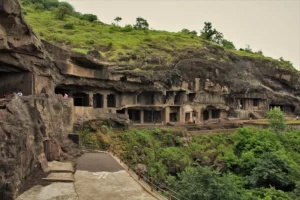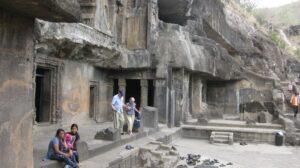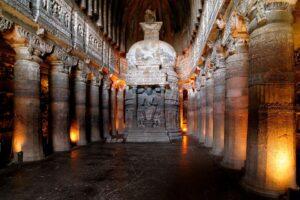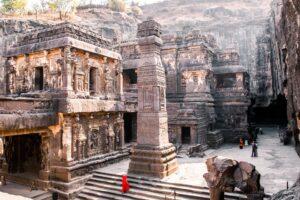Ajanta Caves in Maharashtra 202
Ajanta Caves: A Precious Heritage of Indian Art and Culture
Ajanta Caves in Maharashtra have been constructed by cutting 30 rocks. The artefacts composed inside these Ajanta caves are Indian ancient Reflect excellence. They have been included in the historical heritage by UNESCO. The exquisite sculpture and frescoes found in the Ajanta caves are well-known. Ajanta Caves are one of the precious heritages of Indian history.

Ajanta Caves in Maharashtra are famous all over the world for their art, culture and history. Ajanta caves are located in the Aurangabad district of Maharashtra. Ajanta caves are known all over the world for their Buddhist painting and sculpture. These Ajanta caves were built between the 2nd century BC to the 7th century. Ajanta Caves have been included in the World Heritage Site by UNESCO. Ajanta caves present a unique example of Indian history. Today we will understand in detail the historical, cultural and religious importance of Ajanta Caves in Maharashtra.
Historical Introduction to Ajanta Caves in Maharashtra
These Ajanta caves were constructed during the time of Buddhism. That was the peak time for Buddhism. These Ajanta caves were built for the meditation and meditation of Buddhist monks. So that they can learn about all the fellowships of Buddhism during their study. Paintings and sculptures carved inside the caves Shows the most exquisite examples of the art and culture of ancient India. Ajanta caves were the main centers of the spread of Buddhism.

The Ajanta Caves were constructed in two main phases:
The first phase is considered to be the period from the 2nd century BC These Ajanta Caves in Maharashtra were excavated and painted at that time by the empire of the Satavahana rulers. The second phase is between the fifth and seventh centuries. The second phase took place under the patronage of the Wakataka kings, at that time the influence of Gupta art and culture was seen.
Architecture and structure of Ajanta Caves in Maharashtra
There are a total of 29 caves in the Ajanta Caves in Maharashtra the shape of these caves, built on the banks of the Wadhura river, appears to be like a horseshoe.
These caves are mainly in two ways:
- Vihara (Monastery) This place was the place of residence and meditation of Buddhist monks. These monasteries generally had wide courtyards. There were living rooms for Buddhist monks which were in a row.
- Chaityagriha (Stupa Sthal) These Ajanta caves were built only for worshiping and meditating. The Ajanta caves was built as an image of Lord Buddha. The stupas built inside these caves are considered by Buddhist monks to be the form of Lord Buddha.
Paintings of Ajanta Caves
The paintings made inside the caves of Ajanta Caves in Maharashtra present the oldest and exquisite example of Indian painting. These arts are considered as one of the most important paintings in Indian history. To have a real glimpse of the life of Lord Buddha, one should visit the caves of Ajanta once. Events related to the life of Lord Buddha and the Jataka stories are depicted on the walls of the Ajanta caves.
1.Jataka Stories: The description of Lord Buddha’s previous birth is found in these Jataka stories. About it is painted on the walls of these caves. The messages of humanity, compassion and love have been depicted through these wall paintings.
2.Life of Buddha: Some of the paintings seem to depict the life of Mahatma BuddhaSuch as his birth, knowledge, his life and nirvana are revealed.

Following are the characteristics of Ajanta painting:
Descriptive Style: Every aspect of his life has been monitored through pictures.
Use of natural colors: Natural colors have been used to make these paintings made inside the Ajanta Caves in Maharashtra Which faded over time. But even today there is no decrease in their beauty. Human emotions: The characters in these paintings are uniquely created to show human emotions clearly. This is what makes these paintings great. This art was one of the most exquisite arts of that time.
Sculpture
As good as the paintings are carved inside these caves, the sculpture of Ajanta caves is equally unique. Inside these Ajanta caves, the figures of Lord Buddha and other Buddhist religious leaders have been carved on stone. Highly skilled craftsmen have been performed in these sculpture constructions. This period was the highest period of Indian painting. The Buddha’s stance, his contemplative countenance, and his compassionate spirit are all expertly portrayed in these sculptures.
Buddhism and Ajanta Caves
The Ajanta caves reflect the cultural and social significance of Buddhism. It was inside these Ajanta caves that Buddhist monks meditated and recited prayers. Inside these caves, there is also a mention of the teachings and teachings given by Lord Buddha.

Which depicts the teachings and religion given by Lord Buddha through pictures. Mahayana, Hinayana are the two major branches within Buddhism. Ajanta caves are also considered to be the meeting place of these two. The work of installing the idols of Lord Buddha inside the Ajanta caves was done by the Mahayana branches and started worshipping them. While the Hinayana branch-built Stupa. Both these branches adopted the same religion.
Ajanta Caves: UNESCO World Heritage Site
The work of incorporation of Ajanta Caves in World Heritage was done by UNESCO in 1983.This recognition was given keeping in mind the historical, cultural and artistic significance of Bodh Dharma. Ajanta caves are an invaluable heritage for India and hold an important place all over the world. The art and sculpture of Ajanta Caves in Maharashtra attracts historians, art lovers and tourists from all over the world.

Conservation of Ajanta Caves
The Archaeological Survey of India (ASI) is responsible for securing the Ajanta Caves in Maharashtra. By the way, the Archaeological Survey of India takes care of every heritage of India. These have to be kept much safer in view of human interference and human degradation. But preserving the Ajanta caves’ historic architecture is a difficult process. However, the Archaeological Survey of India has been making many efforts to preserve these paintings and sculptures through its own. Many techniques are being used to keep them safe.
Ajanta Caves and Tourism
Ajanta caves attract not only tourists from India but tourists from all over the world. Ajanta Caves in Maharashtra are quite popular among foreign tourists. Year after year, millions of tourists come here from abroad. They are crazy about the art of tourist India, India culture and history here. those who are curious to learn regarding Indian history, art, and culture.
conclusion
Ajanta Caves in Maharashtra present a unique example of India’s culture art. which would provide us with an interesting insight into the art, religion, and society of ancient India. Today the oldest heritage in the world is inside India. Not only have the paintings, carvings, and dwellings here augmented Indian culture, but they have also left their mark as worldwide treasures.
The message we get from the Ajanta caves is that how deep was the importance of art and culture in Indian ancient times. Correspondingly, we should keep protecting our valuable inheritance. Preservation of these historical heritage is not only the job of the government, but the common man should also perform his duty.
Comments
Post a Comment